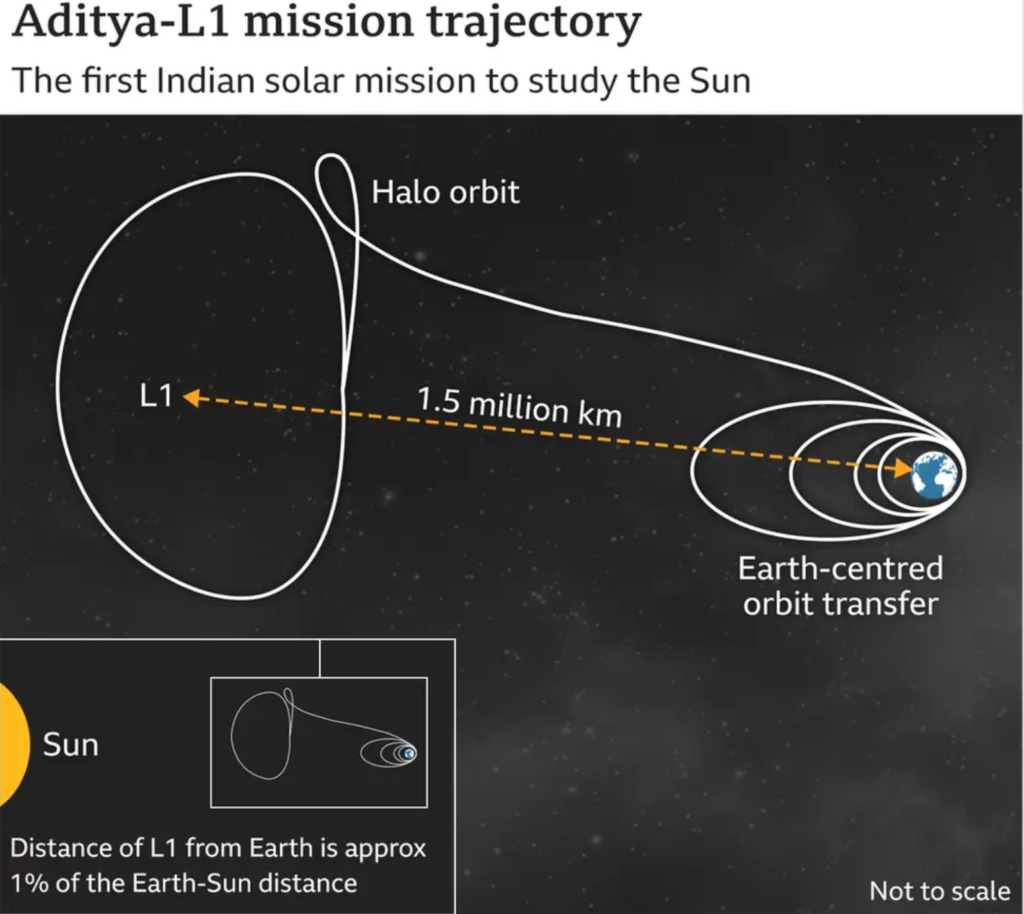
Aditya-L1: India successfully launches its first mission to the Sun
India has marked yet flipside historic milestone in its space exploration endeavors, launching its maiden observation mission to the Sun mere days without achieving the remarkable feat of landing near the Moon’s south pole. Named Aditya-L1, this mission embarked on its journey from the Sriharikota launch pad on a unexceptionable Saturday morning at 11:50 Indian time (06:20 GMT).
The voyage of Aditya-L1 spans an impressive 1.5 million kilometers (932,000 miles) from Earth, a mere 1% of the Earth-Sun distance. This wide-stretching loftiness will necessitate approximately four months to cover. Named without Surya, the Hindu god of the Sun, Aditya-L1 is moreover accompanied by the designation “L1,” denoting Lagrange point 1—the precise location situated between the Sun and Earth to which this Indian spacecraft is destined.
A Lagrange point, as described by the European Space Agency, represents a region where the gravitational forces of two substantial godhead bodies, in this case, the Sun and the Earth, neutralize each other. This unique foible permits a spacecraft to seemingly “hover” in this area. Upon reaching this strategic “parking spot,” Aditya-L1 will synchronize its orbit with the Sun, matching the Earth’s rotation. This structuring reduces the satellite’s fuel consumption considerably, a significant wholesomeness for its longevity and operational efficiency.

The launch of Aditya-L1 attracted the sustentation of thousands who gathered at the viewing gallery established by the Indian Space Research Agency (ISRO) near the launch site. Millions increasingly witnessed the event via live national television broadcasts. Commentators described the launch as “magnificent,” while ISRO scientists spoken the mission’s success and confirmed that its performance was within normal parameters.
Before setting its sights on L1, Aditya-L1 will well-constructed several orbits virtually Earth. Once positioned at L1, it will have an uninterrupted view of the Sun, plane during eclipses, enabling it to self-mastery continuous scientific observations.
While ISRO has not disclosed the mission’s word-for-word cost, reports in the Indian media suggest a upkeep of 3.78 billion rupees ($46 million; £36 million). Aditya-L1 is equipped with seven scientific instruments designed to study various aspects of the Sun, including the solar corona (the outermost layer), the photosphere (the Sun’s visible surface), and the chromosphere (a thin plasma layer between the photosphere and the corona). These studies will enhance our comprehension of solar phenomena like solar wind and solar flares, as well as their effects on Earth’s weather and near-space conditions in real-time.
Former ISRO scientist Mylswamy Annadurai highlights the pivotal role of the Sun in influencing both Earth’s weather and space conditions. Space weather, driven by solar radiation, heat, particle flows, and magnetic fields, significantly impacts the functionality of satellites. Solar winds and storms can disrupt satellite electronics and plane forfeiture power grids. Annadurai underscores that despite these hair-trigger connections, there are gaps in our knowledge of space weather. Aditya-L1 promises to fill some of these gaps, enhancing our topics to predict and respond to space weather-related challenges.
With over 50 operational satellites in space, India relies on its space resources for hair-trigger services such as communication, weather data, and disaster prediction. As the United Nations Office for Outer Space Affairs (UNOOSA) reports, the Earth’s orbit hosts approximately 10,290 satellites, with nearly 7,800 of them currently operational. Aditya-L1 is poised to play a pivotal role in safeguarding these vital resources by providing early warnings of solar worriedness that might stupefy them.
In essence, India’s solar mission represents a significant stride in comprehending and safeguarding the Sun, the godhead entity that anchors our solar system. By largest understanding solar dynamics, Aditya-L1 has the potential to proffer the operational lifetimes of satellites and contribute to the scientific knowledge that underpins our grasp of the Sun’s profound influence on our planet.
India’s foray into solar exploration follows its groundbreaking victory of landing a probe near the lunar south pole, solidifying its position as the fourth nation globally to unzip a soft lunar landing, joining the ranks of the United States, the former Soviet Union, and China.
In an international context, India’s Aditya-L1 mission aligns with the pursuits of other space agencies such as Japan, which initiated solar flare studies in 1981. Additionally, NASA and the European Space Agency (ESA) have monitored the Sun since the 1990s, with NASA’s Solar Orbiter mission and the Parker Solar Probe marking recent advancements in solar exploration.
As India charts new frontiers in space exploration, its ventures hold the promise of expanding humanity’s understanding of the Sun, an astronomical entity that has shaped our world for 4.5 billion years and continues to exert a profound influence on our lives and technology.
Thanks for reading from Storify News as a online news publishing website from India. You are self-ruling to share this story via the various social media platforms and follow us on; Facebook, Twitter, Google News, Google, Pinterest etc.
Disclaimer: The news and image presented in this vendible is based on BBC News and does not necessarily reflect the views or opinions of the author.
The post Aditya-L1: India successfully launches its first mission to the Sun first appeared on Storify News.
 The Defence Blog
The Defence Blog